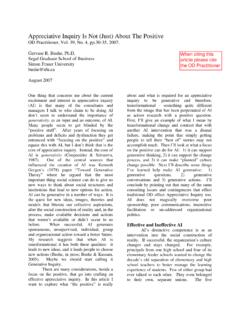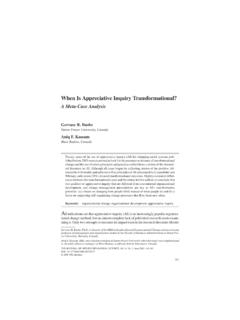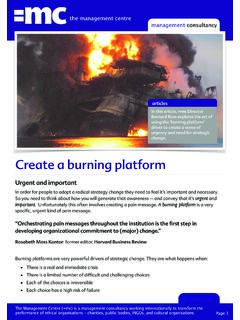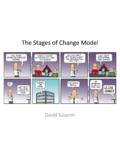Transcription of Five Theories of Change reformatted - Gervase Bushe
1 five Theories of Change Embedded in Appreciative Inquiry Gervase R. Bushe Segal Graduate School of Business Simon Fraser University Vancouver, BC, Canada Presented at the 18th Annual World Congress of Organization Development, Dublin, Ireland, July 14-18, 1998. Published in Cooperrider, D. Sorenson, P., Whitney, D. & Yeager, T. (eds.)(2001) Appreciative Inquiry: An Emerging Direction for Organization Development ( ). Champaign, IL: Stipes and in Cooperrider, D. Sorenson, P., Yeager, T. & Whitney, D. (eds.) (2005) Appreciative Inquiry: Foundations in Positive Organization Development (121-132). Champaign, IL: Stipes. Annotation: Bushe describes five different ways of thinking about how an appreciative inquiry can create Change in social systems.
2 These are the social construction of reality, heliotropic hypothesis, the organizational inner dialogue, paradoxical dilemmas and appreciative process Theories of Change . Each directs us to different ways of thinking about and implementing an appreciative inquiry when our purpose is developmental Change . The key data collection innovation of appreciative inquiry is the collection of people's stories of something at it's best. If we are interested in team development, we collect stories of people's best team experiences. If we are interested in the development of an organization we ask about their peak experience in that organization. If enhanced leadership is our goal, we collect stories of leadership at its best.
3 We need to embrace different ways of inquiring appreciatively but to do so, we need theory that tells us what ways will work -- how and why. In this paper, Bushe offers a way to begin thinking about these questions. In this paper I will describe five different ways of thinking about how an appreciative inquiry can create Change in social systems. Appreciative inquiry is a form of action research that attempts to create new Theories /ideas/images that aid in the developmental Change of a system (Cooperrider & Srivastva, 1987). The key data collection innovation of appreciative inquiry is the collection of people s stories of something at it s best.
4 If we are interested in team development, we collect stories of people s best team experiences. If we are interested in the development of an organization we ask about their peak experience in that organization. If enhanced leadership is our goal, we collect stories of leadership at its best. These stories are collectively discussed in order to create new, generative ideas or images that aid in developmental Change of the collectivity discussing them. I am concerned that as appreciative inquiry becomes "fashionable" two undesirable things are happening. One is that any inquiry that focuses on the "positive" in some way gets called appreciative inquiry (AI).
5 I have already come across a consulting firm that asked people to rate how good the organization was on a number of items on a 5 point scale and called this appreciative inquiry. The result will be that the unique power of this idea gets corrupted and lost and appreciative inquiry becomes just another discarded innovation on the junk heap of "failed" management effectiveness strategies, like QWL, TQM, BPR, etc., Anyone involved in any of these processes knows they all contained excellent ideas and useful techniques but "failed" because of consultants calling whatever they did by the currently fashionable acronym who sold these to managers who didn t know the difference.
6 A second concern is that some practitioners, especially graduate students, can develop a zealous attention to "appreciation" without any theoretical rhyme or reason to their practice. Promoting appreciation where there has been little can, of itself, generate a wave of energy and enthusiasm but that will go away just as quickly as the next challenge or tragedy to a social system rears its head. In this paper I want to appreciate appreciative inquiry as, itself, a generative metaphor that has Bushe five Theories of Change 2led me to new ideas and images of how to Change social systems. I do this also to caution against the indiscriminant application of appreciative inquiry, calling for a disciplined and reasoned approach to its use.
7 I believe that AI can be very helpful in the right time and the right place. We need, however, to develop a model of where and when that is. Some people seem to believe that use of appreciative inquiry is more an ideological than practical question, and that its use will always have a positive effect. I strongly question that. From a purely practical standpoint I think researchers and consultants will find that systems full of deeply held and unexpressed resentments will not tolerate an appreciative inquiry until there has been some expression and forgiving of those resentments. From a theoretical perspective there is the question of what happens to negative images and affect if they are "repressed" from collective discussion by a zealous focus on the "positive".
8 Experience from psychoanalysis, sociology and medicine suggest repression usually results in some nasty side effects. Secondly, we need to embrace different ways of inquiring appreciatively but to do so, we need theory that tells us what ways will work how and why. In this paper, I offer a way to begin thinking about both questions, especially the latter. I will first review two key Theories of Change contained in the writings of Cooperrider: the social construction of reality and the heliotropic hypothesis . Then I will present three ideas that I have stumbled across in my use of AI: the organization s inner dialogue , resolving paradoxical dilemmas, and appreciative process.
9 Each directs us to different ways of thinking about and implementing an appreciative inquiry when our purpose is developmental Change . Socially Constructing Reality Those familiar with AI know that the dominant theoretical rational for AI is post modernist European philosophy (for an excellent summary related to this theory of Change see Barrett, Thomas & Hocevar, 1995). From this point of view there is nothing inherently real or true about any social form. All social organization is an arbitrary, social construction. Our ability to create new and better organizations is limited only by our imagination and collective will.
10 Furthermore, language and words are the basic building blocks of social reality. Rather than seeing language as a passive purveyor of meaning between people, post modernists see language as an active agent in the creation of meaning. As we talk to each other, we are constructing the world we see and think about, and as we Change how we talk we are changing that world. From this perspective, theory, especially theory that is encoded in popular words or images, is a powerful force in shaping social organization because we "see what we believe". Creating new and better Theories /ideas/images is, therefore, a powerful way of changing organizations.













